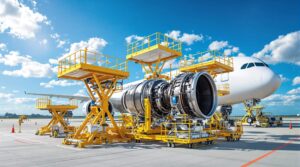The price of aircraft fuel is a dynamic factor influenced by various elements, such as global oil prices, geopolitical events, and market demand. At the core of this expense is the type of fuel used, with aviation primarily relying on jet fuel. The cost per gallon of jet fuel can fluctuate, impacting the overall operational expenses for airlines and private jet owners.
On average, the cost of aviation fuel ranges between $3 to $6 per gallon, but this can vary significantly based on the aforementioned factors. The aviation industry has witnessed both spikes and dips in fuel prices, making it a key variable in financial planning for airlines.
For airlines, fuel expenses constitute a significant portion of their operational costs, sometimes even surpassing personnel expenditures. This has led aviation companies to explore fuel-efficient technologies, alternative fuels, and strategic routes to optimize fuel consumption and mitigate the impact on their bottom line.
Despite the seemingly high cost of aircraft fuel, the aviation industry remains profitable due to a combination of factors. Efficient fleet management, demand forecasting, and ticket pricing strategies contribute to the financial viability of airlines. Additionally, factors like increased air travel demand, cargo services, and international routes play a pivotal role in sustaining profitability.
Moreover, the aviation sector has witnessed advancements in fuel-efficient aircraft designs, contributing to reduced fuel consumption per passenger-mile. This not only benefits the environment by lowering carbon emissions but also aids airlines in maintaining a profitable operation.
When considering the profitability of aircraft fuel, it’s essential to analyze the overall business model of aviation companies. While fuel costs pose a challenge, the industry’s ability to adapt to changing market conditions and implement innovative strategies has proven its resilience.
Operating costs and aircraft fuel expenses
Operating costs in the aviation industry are a critical component that significantly impacts the overall financial health of airlines. One of the major contributors to these costs is aircraft fuel expenses, a variable expense that fluctuates based on fuel prices and consumption.
The aviation sector is highly sensitive to changes in fuel prices, and airlines employ various strategies to manage and mitigate the impact of volatile fuel costs. Fuel expenses can account for a substantial portion of an airline’s operating budget, and any fluctuations in prices directly influence the bottom line.
Fuel efficiency is a key focus for airlines, with the industry continually investing in modern aircraft equipped with advanced technologies to optimize fuel consumption. The use of lightweight materials, aerodynamic designs, and more fuel-efficient engines plays a crucial role in reducing overall fuel expenses.
Moreover, airlines engage in fuel hedging to minimize exposure to price volatility. Fuel hedging involves entering into financial contracts to secure the purchase of fuel at predetermined prices, providing a level of cost predictability in an unpredictable market.
Aside from fuel, operating costs encompass a wide range of expenditures, including maintenance, crew salaries, airport fees, insurance, and aircraft depreciation. These costs collectively contribute to the total cost per available seat mile (CASM), a key metric used in the aviation industry to evaluate operational efficiency.
It’s important to note that the aviation industry’s operating costs can vary significantly among different carriers, depending on factors such as fleet composition, route networks, and business models. Low-cost carriers, for example, often adopt a more streamlined approach, focusing on cost-saving measures to offer competitive fares to passengers.
In analyzing operating costs, airlines carefully evaluate the cost per seat mile to assess their financial performance and identify areas for potential improvement. This metric provides a standardized measure that facilitates comparisons across the industry.
Cost-saving initiatives are a constant pursuit for airlines, involving strategic decisions on fleet renewal, route optimization, and the adoption of new technologies. By embracing innovative solutions and operational efficiencies, airlines aim to enhance their overall cost-effectiveness.
Aircraft fuel efficiency and consumption
Air travel, a marvel of modern engineering, has become an integral part of our globalized world. Yet, the soaring demand for air transportation comes with environmental concerns, prominently centered around fuel consumption. In the pursuit of a sustainable future, the aviation industry is placing an ever-increasing emphasis on efficiency to achieve significant savings and contribute to a greener economy.
The heart of this environmental quest lies in enhancing aircraft fuel efficiency. It’s not merely a matter of technological innovation but a comprehensive strategy that spans design, operations, and fuel management. The aviation sector is investing heavily in cutting-edge technologies to develop fuel-efficient aircraft, a pivotal step towards reducing overall fuel consumption.
One of the key players in this revolution is the development of advanced materials. Aircraft manufacturers are increasingly incorporating lightweight yet durable materials, significantly reducing the weight of aircraft. This weight reduction translates directly into improved fuel efficiency, as airplanes require less energy to stay airborne, resulting in substantial fuel savings over long-haul flights.
Engine efficiency is another critical aspect in the drive to optimize fuel consumption. Modern jet engines are designed with state-of-the-art technology, featuring high-bypass ratios and improved aerodynamics. These advancements not only enhance the overall performance of the aircraft but also contribute to a noteworthy increase in fuel efficiency, aligning with the industry’s commitment to a more fuel-efficient economy.
Operational measures play a crucial role in achieving fuel efficiency. Airlines are adopting innovative strategies such as optimizing flight routes, implementing advanced air traffic management systems, and employing fuel-efficient ascent and descent profiles. These initiatives not only reduce fuel consumption but also contribute to the broader goal of building a more sustainable aviation economy.
Investments in research and development are paving the way for groundbreaking solutions to address the challenge of fuel efficiency. Biofuels, for instance, are emerging as a promising alternative to traditional aviation fuels. Made from renewable sources, biofuels offer a sustainable option, minimizing the environmental impact and fostering a more eco-friendly approach to fuel consumption.
Efforts towards fuel efficiency are not only environmentally responsible but also economically sound. Airlines are recognizing the dual benefits of reducing their carbon footprint and achieving substantial cost savings. This harmonious blend of environmental consciousness and economic prudence underscores the pivotal role of fuel efficiency in shaping the future of air travel.
Environmental impact of aviation fuel
Aviation fuel plays a pivotal role in the environmental impact of air travel, with its emission of greenhouse gases being a major concern. The combustion of traditional aviation fuels releases substantial amounts of carbon dioxide (CO2), contributing significantly to the global warming crisis. As the aviation industry continues to soar, addressing these emissions becomes paramount for a sustainable future.
The issue of pollution extends beyond CO2, encompassing other harmful byproducts. Nitrogen oxides (NOx) and particulate matter released during the combustion process pose threats to air quality and public health. These pollutants not only degrade the atmosphere but also have far-reaching consequences on ecosystems and human well-being.
To combat the adverse environmental effects, the aviation industry is actively exploring and implementing green initiatives. The development of alternative aviation fuels derived from sustainable sources, such as biofuels and synthetic fuels, has gained momentum. These alternatives aim to reduce the industry’s reliance on conventional fossil fuels, mitigating both emissions and the depletion of finite resources.
The quest for eco-friendly aviation solutions extends beyond fuel composition. Advancements in aerodynamics, engine efficiency, and operational practices also contribute to minimizing the industry’s ecological footprint. Aircraft manufacturers are investing in innovative designs, and airlines are adopting fuel-efficient routes and practices to optimize their environmental impact.
| Aspect | Impact |
| Greenhouse Gas Emissions | High, contributing to global warming. |
| Pollutants | Release of NOx and particulate matter, affecting air quality. |
| Alternative Fuels | Exploring biofuels and synthetic fuels to reduce environmental impact. |
| Technological Advancements | Improving aerodynamics, engine efficiency, and operational practices. |
As the aviation industry continues to evolve, finding a balance between economic growth and environmental stewardship remains a pressing challenge. The ongoing efforts to enhance fuel efficiency, invest in sustainable alternatives, and embrace eco-conscious practices are crucial steps towards a more sustainable and responsible aviation future.






